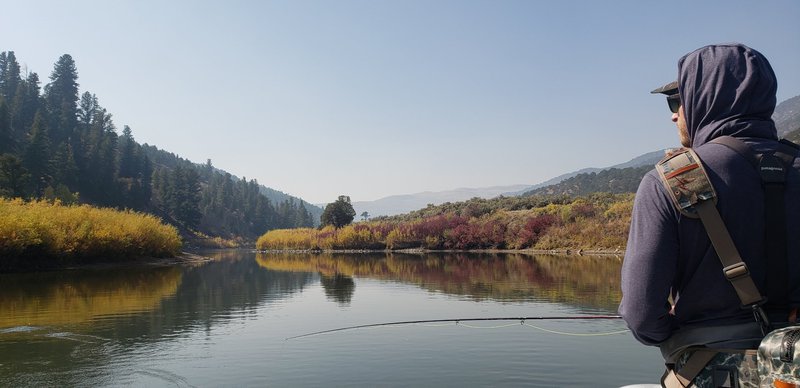Float fishing is easily our favorite way to chase trout. It allows you to explore new water and cover more ground while having a few beers and laughs with close friends. Not only that, your ability to avoid the foot soldiers stacked up along the banks across the front range is much easier. In Colorado, the water flowing through the river is public land. So as long as you don’t get out of your boat or anchor down, you can take advantage of water flowing through private lands as well. While there are a number of advantages that go along with float fishing, we thoroughly understand that there is a bit of a learning curve to get up to speed. As such, we’ll walk you through a few tips and tricks for success when it comes to fly fishing from a boat.

- Where on the water to fish: Similar to wading, the answer to this depends largely on the flow of the water and the season. However, when fishing from a boat you can easily cover more of a particular section of water, especially when it comes to bigger freestones. This topic could easily have it’s own blog, but in general you can’t go wrong fishing five to ten feet off the banks, the outer seams, foam lines and frog water (deep and slow moving).
- Keep it simple and think big: One of the many advantages of float fishing is that you can cover a lot of water and sections that are not heavily pressured by anglers making countless casts from the shore. With this in mind, we prefer to keep it simple when it comes to our rigs. If you are nymphing or fishing streamers, start by making sure you have the right depth. Split shot is helpful when it comes to dialing it in, but we like to start with comparatively bigger lead flies with tungsten beads so as to get our flies down as quickly as possible. Additionally, you’ll want to consider using a heavier tippet and leader (no smaller than 4X) as it will allow you to control the fish on the end of your line while moving down the river. However, you may need to downsize above 4X if you are fishing smaller dries.
- Stay within your comfort zone: While there is a time and a place for that hero cast where you’ve got one shot to tuck your flies along the bank below thick brush, it is generally in your best interest to fish within your means. By this we mean, don’t cast further than you are comfortable with. Instead, put the boat in a position to make a clean drift.
- Look ahead: Unlike wading, where you’d cast upstream, when fishing from a boat it is imperative to be looking ahead and fish downstream. Otherwise, you risk creating unnecessary drag on your line leading to an unnatural drift and ultimately fewer fish in the net. Depending on where on the water you are fishing, you’ll want to have the boat captain positioned 10 feet or so from the desired drift. If you are fishing a couple feet off the banks, you’ll want to cast in front of the boat at the lowest angle possible that puts your flies in front of the most fish.
- The mend is your friend: Like any form of fly fishing, line management is crucial to success and the mend is arguably the most dangerous of weapons under this category. If the goal is to present your flies naturally drifting through the water and you’ve got a ton of slack dragging them down or upstream, you’re going to have a tough time catching trout. Do yourself a favor and only cast as much line as you need and mend it so that it is not creating drag.
- Hooksets are free: This is true for any form of fly fishing. However, we’ve found ourselves getting lazy after a number of snags. Be diligent and don’t get lazy. Tailwaters are not the only place you find fickle trout and subtle takes. When it comes to the direction of your hookset, it can be a little less intuitive given you are fishing downstream and trout are facing toward the boat. If you are in a position to set the hook downstream, do so. Otherwise, set the hook upward and preferably to one side of your drift.
- Don’t be afraid to get out of the boat and dial it in: Naturally, when fishing from a boat you have less time to hone it in when it comes to your flies as you really only get one, maybe two shots at a given drift. If you’re not seeing results, make sure you’re following the aforementioned tips. Otherwise, there’s nothing wrong with taking 20 to 30 minutes to get out of the boat and cycle through a few flies until you’ve determined what’s working.
